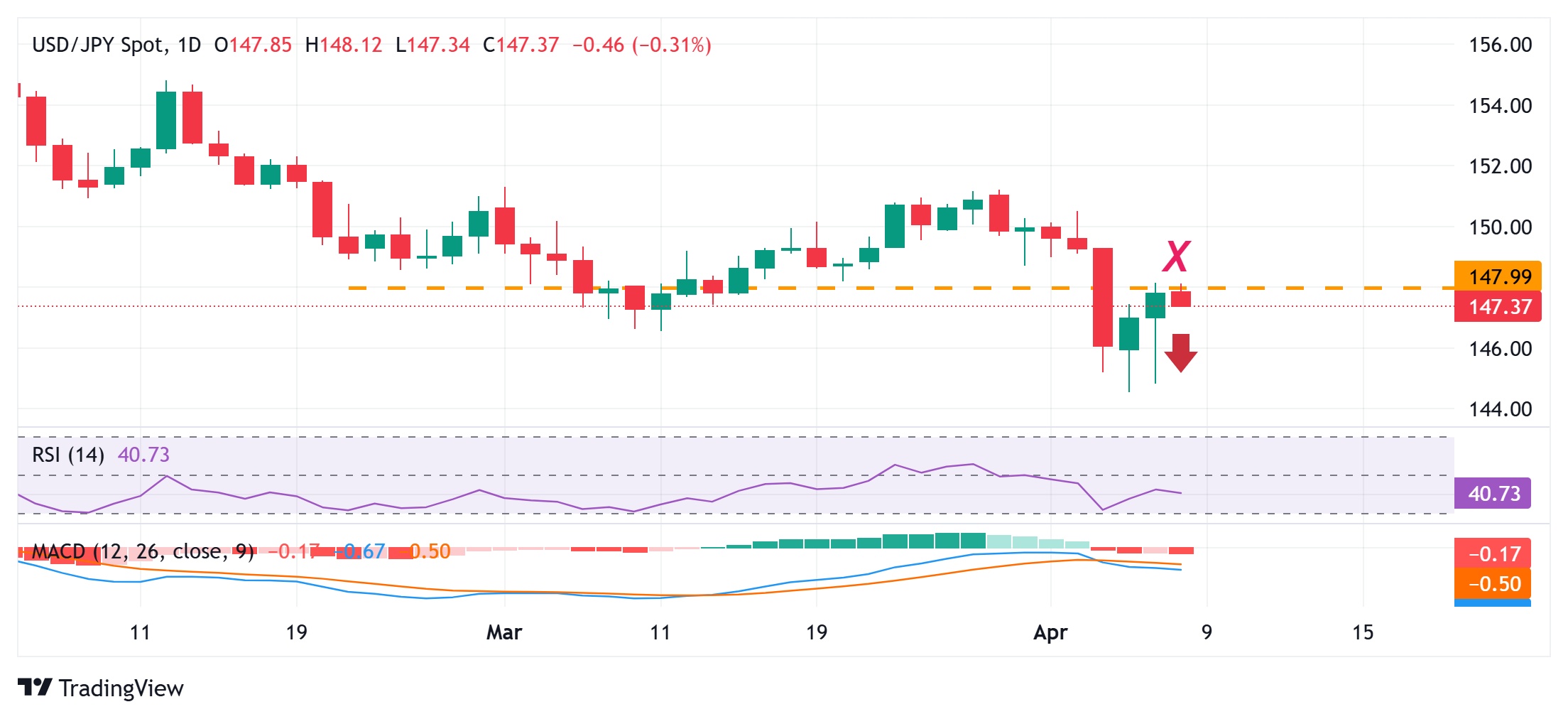Created
: 2025.04.08














![]() 2025.04.08 11:24
2025.04.08 11:24
The Japanese Yen (JPY) edges higher against its American counterpart during the Asian session on Tuesday and for now, seems to have stalled the previous day's sharp retracement from the vicinity of the multi-month peak. Despite growing concerns that harsher US reciprocal tariffs could negatively impact Japan's economy, signs of broadening inflation in Japan keep the door open for further interest rate hikes by the Bank of Japan (BoJ) in 2025. This, in turn, is seen as a key factor that continues to lend support to the JPY.
Furthermore, concerns about the global economic disruptions caused by US President Donald Trump's reciprocal tariffs benefit the JPY's relative safe-haven status. Meanwhile, traders have been pricing in the possibility that a tariffs-driven US economic slowdown might force the Federal Reserve (Fed) to cut interest rates aggressively. This marks a big divergence in comparison to hawkish BoJ expectations, which stalls a two-day-old US Dollar (USD) recovery from a multi-month low and further underpins the lower-yielding JPY.

From a technical perspective, the USD/JPY pair's inability to find acceptance above the 148.00 mark and the subsequent slide warrant caution for bullish traders. Moreover, oscillators on the daily chart are holding in negative territory and are still away from being in the oversold zone, validating the near-term negative outlook for the currency pair. However, a sustained move beyond the Asian session high, around the 148.15 region, might trigger a short-covering rally and lift spot prices to the 148.70 intermediate hurdle en route to the 149.00 round figure. The next relevant barrier is pegged near the 149.35-149.40 region, which if cleared should pave the way for a move towards reclaiming the 150.00 psychological mark.
On the flip side, the 147.00 mark could offer some support, below which the USD/JPY pair could accelerate the slide back towards the 146.00 round figure before dropping to the 145.40 region. Some follow-through selling could make spot prices vulnerable and may weaken further below the 145.00 psychological mark and test the multi-month low, around the 144.55 region, touched on Monday. The subsequent downfall has the potential to drag the currency pair towards the 144.00 mark.
The Japanese Yen (JPY) is one of the world's most traded currencies. Its value is broadly determined by the performance of the Japanese economy, but more specifically by the Bank of Japan's policy, the differential between Japanese and US bond yields, or risk sentiment among traders, among other factors.
One of the Bank of Japan's mandates is currency control, so its moves are key for the Yen. The BoJ has directly intervened in currency markets sometimes, generally to lower the value of the Yen, although it refrains from doing it often due to political concerns of its main trading partners. The BoJ ultra-loose monetary policy between 2013 and 2024 caused the Yen to depreciate against its main currency peers due to an increasing policy divergence between the Bank of Japan and other main central banks. More recently, the gradually unwinding of this ultra-loose policy has given some support to the Yen.
Over the last decade, the BoJ's stance of sticking to ultra-loose monetary policy has led to a widening policy divergence with other central banks, particularly with the US Federal Reserve. This supported a widening of the differential between the 10-year US and Japanese bonds, which favored the US Dollar against the Japanese Yen. The BoJ decision in 2024 to gradually abandon the ultra-loose policy, coupled with interest-rate cuts in other major central banks, is narrowing this differential.
The Japanese Yen is often seen as a safe-haven investment. This means that in times of market stress, investors are more likely to put their money in the Japanese currency due to its supposed reliability and stability. Turbulent times are likely to strengthen the Yen's value against other currencies seen as more risky to invest in.
![]()
Created
: 2025.04.08
![]()
Last updated
: 2025.04.08

FXStreet is a forex information website, delivering market analysis and news articles 24/7.
It features a number of articles contributed by well-known analysts, in addition to the ones by its editorial team.
Founded in 2000 by Francesc Riverola, a Spanish economist, it has grown to become a world-renowned information website.
We hope you find this article useful. Any comments or suggestions will be greatly appreciated.
We are also looking for writers with extensive experience in forex and crypto to join us.
please contact us at [email protected].
Disclaimer:
All information and content provided on this website is provided for informational purposes only and is not intended to solicit any investment. Although all efforts are made in order to ensure that the information is correct, no guarantee is provided for the accuracy of any content on this website. Any decision made shall be the responsibility of the investor and Myforex does not take any responsibility whatsoever regarding the use of any information provided herein.
The content provided on this website belongs to Myforex and, where stated, the relevant licensors. All rights are reserved by Myforex and the relevant licensors, and no content of this website, whether in full or in part, shall be copied or displayed elsewhere without the explicit written permission of the relevant copyright holder. If you wish to use any part of the content provided on this website, please ensure that you contact Myforex.
Myforex uses cookies to improve the convenience and functionality of this website. This website may include cookies not only by us but also by third parties (advertisers, log analysts, etc.) for the purpose of tracking the activities of users. Cookie policy